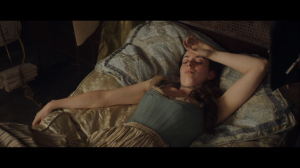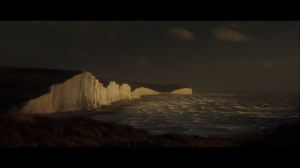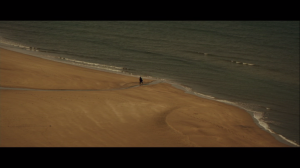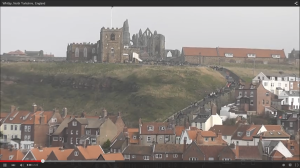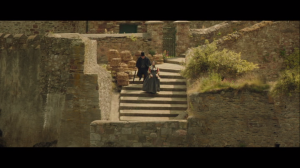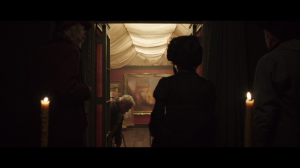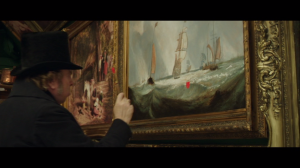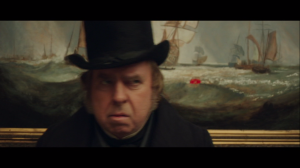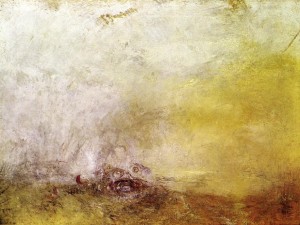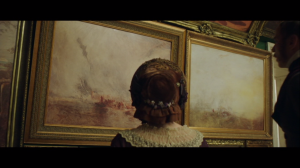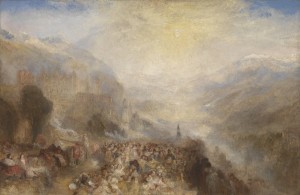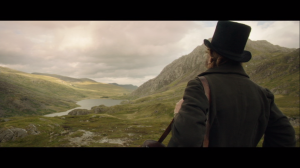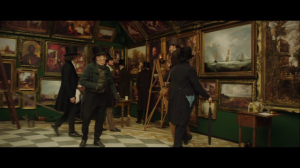rev., June 20, 2015
At one point, in Mike Leigh’s quite good Mr. Turner, Turner comes back from sketching a prostitute, having, off screen, asked her to remove her top, and, since he is aroused, he takes advantage of his maid by catching her from behind as she is dusting the bookshelf. She is depicted as a lowly person who has submitted to this type of thing as one of the conditions of her employment, and the way she enjoys it means she knows this is where she is getting sex in life, and had better be Ok with it, and maybe in her more girlish moments even fancies that, because of such attacks, he fancies her. So, he lifts her dress, and goes into her
And then we see him smash her up against all of his books, the whole thing precipitated by the reaching for a book, her head actually crushed into the books
In some ways, this scene exemplifies both the promise and the problems in the movie. Just before, he had been in a private chamber with a prostitute, and, before cutting off screen, he had asked her to remove her top,
And yet it is not apparent that he allowed himself the freedom of having her sexually. This means that he had a method and that method involves sketching and his art, and not mixing up the two. This suggests that his art practice is one thing, but his private life is another. That is, one must not make too much of direct explanatory connections between his life and his art, because his art existed by this point in his career on a different level, and in a completely different state of mind. And the main element in the different state of mind in his art was, not sex or his sexual problems, but books—books are the key to the real Turner. This notion is perhaps, I am not sure about this, conveyed purely visually by two shots that more or less frame this section of the movie: after his father dies, when his previous way of life with father as manager is disrupted, and he must seek out another way of life with another person to often companionship. Earlier, there is an aerial view of a spiral staircase, I am not entirely sure of the context, but…..in all horror movies, and all movies, this shot represents the wormhole down which a life is swirling, from rational to irrational, from regular to extraordinary, from waking to dream state. It means that he is falling, and he is scrambling to make up a new reality
not soon after we get him to Margate down on the English Channel, and here again, as in thousands of other English movies, horror and otherwise, a clifftop view of the rocky depths and crashing surf below signifies his peril. This shot is in itself a visualization of suicidal ideation, and represents crisis. He may be drawing, but he is drawing on the edge (though the beach is placid that day)
We have previously been given notice that he goes on drawing safaris. One of the best sequences of the movie, and the one most lifelike to the practice of an artist, is that he goes off for days to private places like a lodging just over the port and the water at Margate to sit at a window and draw. The Margate set is terrific. It has a curved promenade, a busy seaport bustle, and a cozy English feel, it feels like a dream
It is also of interest that he is incognito, and seeks out a window on the upper floor, in a rented room.
This sequence parallels strongly with many others expressing the split nature of the life of a male in 19th century or later England. In The Picture of Dorian Gray, Dorian too often goes out, and disappears for awhile.
In Werewolf of London, and again in The Invisible Man, it is exactly to this sort of lodging that he goes. The room and the housekeeper are not that different than those in, even, the 1913 version of Dr. Jekyll and My. Hyde, when Hyde goes off to a dive
But in his case, while it might be think he goes for lodging, or whoring, or whatever, he goes for art. It again, in the context of its visual tradition, sets art aside from life as a targeted practice with rules of its own. Art is a methodology. But it will be noticed, as previously, that as he did not partake of his model at the whorehouse, so he is not in fact acting like a Sunday painter and setting up shop to make easel paintings of his scenes, he is doing inventory, he has a notebook, and is simply compiling instances of sunset etc which he might then refer to and draw from as from a database of types for his larger, entirely in studio production. On this point, however, distinguishing his particular sketch-database practice from Sunday painter landscape plein air painter, there is some fudging, and perhaps misunderstanding. There is one wonderful shot of the White Cliffs of Dover, which again places this movie is a long tradition of movies with similar shots, but I would say Turner was not a partaker of landscape in that way.
They show him at one time being tied up to the mast, to experience the snow storm, and that indicates to me that he was after effects and not after scenes, that is, he was an effect painter not a scenery painter. The notion that he is a conventional landscape painter might provide some consolation to the many of those painters in the audience, but his practice was much more focused. The clearest breach between a romantic film view of his practice and his actual practice is in this shot of him walking along the surf, as if to simply enjoy the abstract landscape (and again this shot rich in association with other movies in horror and otherwise),
The problem is, again, he did not set up, he was walking looking for effects. Moreover, as scholarship has found, exploring the culture of the time, the beach as moderns know it, as a place of bathing, and of contemplation of the out there, in a placid and serene way, did not exist then. At the end of the movie the fact that he comes out of his house in his gown with a sketchbook to make a sketch of a young lady drowned at sea is I think interpreted as a sign of his loss of power and of his craziness at the end. But, no, he had always only had an interest in the intersection of life and death at the very littoral between them, in those days, the beach. Though here he sketches a dead girl,
Even in the beginning, the beach was a place to go foraging for washed ashore remains of the dead or of ship passage and shipwrecks. It was a zone of death. This shot of him and his new wife walking down the Margate steps reminded me of similar steps at Whitby,
Made deadly in Dracula (this a walk thru the cemetery, in the BBC’s 1977 Dracula)
and that in fact Turner’s practice visa vis the sea was entirely in keeping with the shipwreck washashore events of Dracula 90 years later.
The experience of the British of the beach before 1900 was the experience of it as a border between life and death. He was also looking for artifacts from the realm of death to incite him to create deeper and more profound visions of what death must look like from life. Each artifact would then “have a story” to it and it is in the space between the shore, the artifact and the story, that Turner’s imagination turned on, and he began to create art.
This theme is addressed, as it is Ruskin who purchases his most famous and scandalous painting, of the slave ship wreckage, though ennobling because of its political undertone, but, in truth, this is what was on his mind in most of his nautical paintings, and the political aspect of it only served to inflate the world he expanded his practice over, what he incorporated then often leading to a larger and larger practice (whereas actual landscape practice is actually rather small).
As is
Even his contemporaries diminished his practice, and he had to sometimes admit he was a marine painter, as if he only worked in that scenic genre, with roots going way back. In one nifty sequence he is out with some fellows and they make light of his interests in the marine, and when they come upon the towing of the Tremeraine to its final resting place, they all joke that it would make a great Turner, he grunts assent, at the same time shutting them up, but of course the strange thing is when Leigh sought in film to reproduce the shot as a scenic shot only, it is nowhere the view it is in the painting.
It is beautiful, it is fine, but it has nothing of the depth that the Turner of the same has, here he is working on it, interrupted by this housekeeper (this time no oops sex),
And face to face, not in a movie, even better
how explain this gap? Well, at one point, he visits, I think, the Ruskins, and they make a joke that the house has been built around the painting, so he has no need of praises, and no need to feel neglected in his time. But this aerial shot suggests that he is walking into a place that does not understand, and that the painting is lost on the scene. This kind of shot is usually reserved for haunted houses when someone above is watching something mysterious and incomprehensible taking place below
And indeed when Leigh stages a rather nice conversation on art by the upper class back then, Turner grunts though it, except when Ruskin takes issue with Lorraine, and Turner shoots back that Claude Lorraine is a genius, Ruskin had been complaining of the unreality of Lorraine’s work, Turner defends it, clearly on other grounds
What were those other grounds? It is breaching the opening towards those other grounds that a separate movie hemorrhages out from this purely outside objective view of Mr Turner, to avoid confronting the contemporary cultural truth of the inner life of Turner.
Nancy Andriessen, in The Creative Brain, has argued that artists have different brains than “normal” creative persons. They have laced throughout below the prefrontal cortex, the tempopareital lobes, and on into the realms of working and long term memory in the hippocampus and below, a highly enlarged, because exercised, associative cortex. That means that they have highly developed associative skills, and highly developed apophenic, or pattern finding skills. This accounts for artistic facility in seeing physiogomies in variegated surfaces, in seeing figures in abstract arrangements of forms, and in finding association between objects and ideas otherwise left aloofly unassociated with each other by the standard practice rational mind. The operation of the associative cortex creates a mental high, by which the imagination, activated by the progression of the cortex’s work (the two can be seen as the same), that boggles the mind, and fills one with intense urges to capture the fullness of life, a fullness that exists beyond the categorizing limitations of the standard practice rational mind and its grasp of life. This is the artistic high, and it exists as a result of the artistic process in the mind working on all cylinders, and being on a roll, in the flow, as Cziksentimihalyi states, doing great things. The associative cortex itself is so active that it ever cascades onto the new things, its restlessness prevents commodification of a fixed style, and so it might be argued that the most creative artists are those that wander far and wide in the terrain they have mapped out for themselves.
When young, the cortex and its development is a natural ability, it is the task of the artist to internalize it under the management of the prefrontal cortex a consciously controlled facility. It must be cultured, practiced, worked, or the faculty in time will atrophy. In time, the artist comes to see that his or her associative cortex turns on or off best in the association-charged spaces between certain topics and interests that fuel his or her imagination. In those spaces, is the artist’s sweet spot, which is the peak of imaginative frenzy, captured in art, and in the spaces between the sweet spot of overlap of influences and those influences in what can be called the “wheelhouse” of the artist. This notion can also be superscribed by Uexkill’s notion of the Umwelt, and that an animal or creature creates an Umwelt by means of the operation of a specific set of faculties and skills, and that leads to his survival and even thriving, and any foray out of that Umwelt will lead to disaster. These latter concepts lead to the possibility of being able to graph out, as I now do, the creative life of an artist, and find out exactly where his or her wheelhouse and sweet spot are. This, I believe, can be done. This, needless to say, was not done in Mr. Turner, though hints were made of it.
The key to the mystery for Turner is that his sketching tours were only database adding forays for effects that he could catalog and then make use of. The actual painting vis a vis the scene painted then is by no means a transcript or even a plein air landscape or scenic painting, it is as it were a “fiction” in which elements from as many as a dozen different locals are mined out of his sketchbook and composited to make a superstatement of a higher realm and high associative state experience of his canvases. It is this elevated state visa vis the relatively flat level of cognition of the standard practice rational mind that provided the magic pull of Turner’s work. We get a sense of this a few times in the movie, and sometimes that it is more than just looking. The fact that he has all his paintings all jumbled together in a little gallery, to boggle the mind of his clients with plenitude, bespeaks his desire to create this high, it is an ali baba’s cave effect, The fact that in media res it appeared to be ritualized, with the father serving as maître d, adds to the effect
The fact that like Norman Bates he then has a peephole also suggests a machine well oiled and running well, designed to create an effect, a spectacle, it is interesting in this shot that as Turner peeps on his viewers, in directly, one of those viewers has taken the liberty of finding a distinction between fore and background, and stuck his nose on right up into the painting, again suggesting a reading idea (he also wants to see viewers of his work inside a larger sight of his work being seen, an endless parenthesis that excites him)
during another rather wonderful sequence, expressive of the privacies of a practice, a natural philosopher woman stops by and teaches Turner a few things about light, even projecting a prism on to his canvas, again, a search for effects not scenes
Then as a reward she is shown into the holy of holies, and also overwhelmed, at one point, Turner and father play a game of cat and mouse with her, seeing if she can guess what scene this is,
And then when she is shocked to hear it is Hannibal, she cannot find the elephant, and it has to be pointed out to her, like a visual trick, in a rich panoramas of effects to be taken in sequentially in reading it, bending over as she is
Since she is bent over over Hannibal, but is with Turner for the most edifying reasons, it is fair to compare her to the maid, bent over the bookshelf, and taken for momentary physical needs to be undertaken and got over and done with. But the key allegorical punch of this scene of impromptu intercourse is that she is pressed into the books, that he had a lot of books, is shown reading books, and in discussion of paintings, invariably, though in ways I’m not sure the script understood, brings up quotes or stories, that is, his is a literary effect historical painting, story painting, ut pictura poesis,
Transpose this scene back to the gallery, and he has “intercourse” with an educated woman in another way, she bends over, and takes the art in, but she is an educated woman, once it is pointed out to her, she gets it, she exults and glories, taken out of herself, even there, I suspect there is a sexual metaphor in this rendering of a woman of the time looking intently at art.
The effacement of the storytelling Turner has been a modern project for more than a century. Turner has been the pre-abstract, proto-modernist who took painting to new places through his abstraction, for as long as I can remember. According to this model, Turner got better the more he approached abstraction, and dropped away the extraneous storytelling aspects of his art, encumbrances of an unmodern sort. There is a lot of this prototype modernist Turner in the framework of the movie, in his rather hoaky encounter with a train, in his increasing abstraction, in his messmaking during painting, but this is all the lore of his life, and not the truth of his art. I no longer believe in this imaginary Turner. For example, once in the Salon he does an odd thing, adding a read dot to his painting,
I suspect there is a story here, and the lore might be that, seeing so much red about, and being next o Constable, whose large work has a lot of red, he is making a joke at fashion, by putting a dot of red in. Immediately, scandal, as it is believed he has destroyed his painting. But then he comes back a second time, wipes some of it away, and now it looks inside the picture like a drowning boy gasping for air, so that is OK, the red dot is no longer on the painting, destroying it, it has returned to being in the sea inside the painting, telling of some event
This may have been visual and anecdotal allusion to his later sea monsters, which people began to think mad,
It is really odd how on exhibition day all the artists are hanging about over their paintings, adding on the final touches. At one point he does so too, getting carried away by spilling things and spitting at his painting, which may or may not be apocryphal. I can hardly believe it to be true, but I would argue that such gesturing and antics were part of the “personal mythology” of his art, which is a necessary part of one’s inner life (just as Michelangelo posed as a barbarian).
But then the tides turn, the style begins to change, he gets tooooooo abstract, and now Preraphaelitism comes in, and he feels himself going out of fashion. This part is told rather too schematically, with Queen Victoria deploring the painting,
Then all the ladies following suit, calling it frightful
Then it spreads to the vaudeville, where they mock him as a painter with food and spillage,
Then he gets a gander at the precision of preraphaelitism, and knows his goose is cooked
All this is standard biographical lore, what one might call art history urban legends. But is it true? It might have been true in the parlance of the time, and in the attempt by the news and its commentators to make sense of its times. But, this is too schematic. No, the truer thing that struck me about the vaudeville pantomime was that, not only was Turner at the theater, but it was all in rhyme, and appreciation of pictures were indeed often undertaken through verse back then, in the manner of a kind of poetic ekphrasis. Many of his paintings were indeed put out with poems attached, or were inspired by poems. There was also a whole school of more explicitly literary painters. He likely stirred his own imagination by reading poetry, perhaps he read the classics. He was a man of his time, bringing all time to his times, making his locale eternal through his visionary and transcendental paintings. By that reading, he ought to have applauded the deepening literariness of the preraphaelites, and with but a lesson of two Queen Victoria could have been educated to understand she was being read the classics to. No, the change of taste that ruined Turner in his life was realism, its insistence on physical here and now, and also materialism of a new sort in the bourgeoisie era. This class development, as mapped out by Benjamin, then lead the middle class mind to seek in art escapes from the world, resulting in artists catering more and more to sentimental and hobby-oriented tastes, and thus, albeit also historical and large scale, Landseer and Bonheur took over, leaving Turner’s poetic dreaminess as a relic of the Regency.
But this also gets to the heart of the practice excised from this film, because not believed to be showable, the fact that in my view Turner was primarily a story painter. What do I mean by that? Back to the associative cortex: Andriessen also notes that because of the overheated associative cortex, and the difficulties involved in managing it, artists often suffer, and their proverbial drunkenness may be attributable to a need to be blind to time outside of the bubble. But that only means that the main job of being a mature artist must be to tame and train the cortex and its associating tendencies to come alive, to thrive, and then to remain under control. If you envision the associative cortex as a storytelling organ, then stories linking up serially to each other, may be the umbrella that controls the activity. Strangely enough, across the opening credit, are sent passing wisps of smoke, and their curls and swirls in fact more or less recreate what I think the expanding storytelling associative cortex must look like, if graphed out, a kind of rhizome, my term for the suspended, but concluded upon, and hovering-certain quality of the cortex, when one is in command of it, “the sphinx,” here it is, more or less
There are several ways to tame and manage and gain command over one’s creative faculty. One is to cultivate one’s “thing,” which is a special non-art font of interest that one undertakes for it’s own self and for one’s pleasure outside of art, but it nevertheless serves as a constant source of inspiration for one’s art, and repeatedly gets one past blocks etc etc. For Turner, this was obviously the sea, everybody got that right, but I think it was because the sea was so rich in story and tragedy and history, as it would be thought to be, in the age of Nelson. But he had two loves, he loved the sea for itself, all by itself, and then he loved it for feeding his art. It was the eternal font.
Second, it was necessary to develop a repertoire of characters and themes that one returns to over and over again, because they become the foundation of one’s voice. For Turner, the connecting fabric of his associative cortex were stories, and many of them classical, thus the link to Lorraine. He seems to have fixated on great events of history that happened in, around or at the edges of lakes or seas, but I have not entirely mapped this out (he also liked fires). It is the story that he injects into a landscape scene that dictates what color or intensity of brushstroke he might use. It is the story that is the antenna and the fibre of his art, not the pure painting effects. He goes from story to story, one after the other, they inspire him, and he churns them out, like sequels in a long retelling of world history. In this serial all but redressed mindset he has no problem in repeating himself, because he is telling another story, or the same story a new way. Each one is a story telling performance, as it were. The movie only rarely made mention of this, and never showed it (for example, ignoring his mythological paintings, or classical or even biblical paintings, some of which are my favorite: it also totally ignored his late religious work, which is entirely scripture based). From this also comes a need to create a repertoire of characters and themes, most of this classical too. I did not come to see this in Turner until going through the Tate’s collection of Turners in 2005, seeing Shadrach, Meshach and Abednego and other obscure storyings, I realized that he had whipped up a variation on his normal themes and visual tropes, based on the content of the story.
He was storying landscape. In his most accomplished works I fancy that he worked out an actual telling of the sequence of a story in the effects on canvas so that one would look at the painting in steps that would tell the story to you. One can see how complex one’s interaction is with a storied painting, guided by the informing story, in my analysis, elsewhere, of the 49 steps of looking at Turner’s Ulysses Deriding Polyphemus.
The failure of the movie to entirely go into his subjective state and the Umwelt on the other side of it or through his eyes left us outside visiting Mr. Turner and did not allow us entrée into his more fantasy and imaginative than landscape and positivist-descriptive world. Consider what a dream state he might have had to put himself into to paint the ghosts dancing at the Heidelberg Castle! where is THAT Turner in the movie, nowhere.
Having established a storyline based on a thing, a milieu of interior spaces, reflected in the art’s spaces, is created, this is the physical and landscape expression of the aforementioned Umwelt of connectives and spaces that go to create that special annex of reality, that crawl space in which an artist thrives, in the world. The movie in his trips to Margate did in fact go far to capture how he moved right in and made himself at home in an environment that was in his milieu. However, his milieu, his umwelt, was NOT the sea itself, that was his thing, his inspiring font, his milieu inside his art was the space between a body of water and a story associated with it, triangulated against or associated with a previous story he had told. He might have therefore just been out in Margate collecting some specimens, having a good time, but it is likely the site only excited him because of local stories or lore that made him imagine past events there, then, only when he got it all back to the studio and got to work on a painting put it all together and lead to a high and art did his milieu emerge (I more or less experienced this one summer in Cape May Point, New Jersey, none too exciting until I began to explore, with my kids, pirate, spy, shipwreck, criminal and other Victorian stories, which woke the place up good: the next when I returned we did not go just there but the space between there and all those stories). Physically, the milieu of his art is the sweet spot between water, reflected cloud-infused light and figure, yes, figure, however small, his figures were of immense importance as entrée points into his storytelling (my notion of milieu was developed from looking at how movie directors like Hitchcock or Fisher perpetually zeroed in on variations of the same effect, always after the sweet spot in their milieu).
Overcasting all that then is a resolving philosophy, and that would be his rather existential and fatalistic tendency, his obsession with death and disaster, but in a fatalistic way, I think it fair to say Turner thought the world he painted was coming to an end, and he was painting at the end of the world—but on this point, the movie remains silent.
Only by acknowledging that inside the head of Turner he had wheels spinning out an associative cortex of a highly developed nature which he then cultured based on a persistent obsessive interest, the sea, then managed by arranging serially in a milieu, in a certain relational space, using a number of specific sources to create a wheelhouse, and then casting overall a presiding summative philosophy, only by carefully mapping out and then giving visual insight into those mental dynamics could a movie hope to capture how very exciting indeed it must have been to live inside the head of JMW Turner.
By always showing us Turner standing before a landscape, a landscape painter
The movie might have got some wonderful shots, but it as a result offers no answer to why when he descended then into his public world of art, he does not stand with wonder, but moves through with accepting and lightning speed. Why would he not be offended by all these other pictures all lined up around him, if he was so interested in the view?
The answer is because his picture existed perpendicularly from the viewer through the picture to an imagined reality, in the space behind the picture, in relation of his conjuring of it and the viewer’s ability to be taken up by it, through it, to experience it too, he was not competing with any other picture in the place, he was his own channel, telling his own story, without any complication, a discreet pictorial apparatus, with a life of its own. So he walks up to his stuff, checks it out
Then walks by everything else, except to offer niceties
The whole depiction of him in the salon and his behavior is the subject of another report, it is all very interesting, but would need research to verify. But in any case, it offers some insight into the differentness of the art world then and now, and the irrelevance to a framed work of art of any other work any other side of it, it was expected that one could change the channel to take in the new story and listen to it told, discretely. He saw other works next to his, but he zeroed in, he just wasn’t that interested in how they looked in the broader context of a salon style hanging.
Thus, Turner was a literary-based storytelling artist in the Lorraine tradition who used landscape as a pretext to create story enhancing effects and elevate the viewer to a teleported ideal reality beyond the canvas, above actual reality, but transcending it, a transcendental realist then (it occurs to me applying the model of tableaux paintings and pictures to Turner might also be very helpful). That he used poetry and the reading of the classics to get up to that state is also part of it. He was a painter of the early 19th century, not a projection of a painter of the early 21st century back two hundred years. The movie depicts Mr. Turner as a proto-abstract pure proto-impressionist landscape painter with an abstract imagination fixated only on effects, in keeping with a longstanding modernist myth. By having to tell a story, Mr. Turner inadvertently got it right in some spots, in capturing some aspects of the joy of the creative life, and the movie itself as a Mike Leigh movie has many Leigh joys in describing the awkwardness of social life, but by and large the movie files in alongside of many, many others films which, because of their visual vocabulary, still struggle to envision, after the model of Ken Russell, the inner mental life of the artist. For that reason, it was nice to meet Mr. Turner, but I did not come away thinking that I had encountered the actual JMW Turner, whom, had I met, the very last thing we might have mentioned was that time he got the maid by the bookshelf.
Note: this note based on a model of the inner workings of the creative mind developed from Andriessen, The Creative Brain in c.2005, this model has been refined, and future notes may provide more detailed descriptions of the vectors of creativity detected in Turner’s “sweet spot”or “wheelhouse,” broadly identified here.


